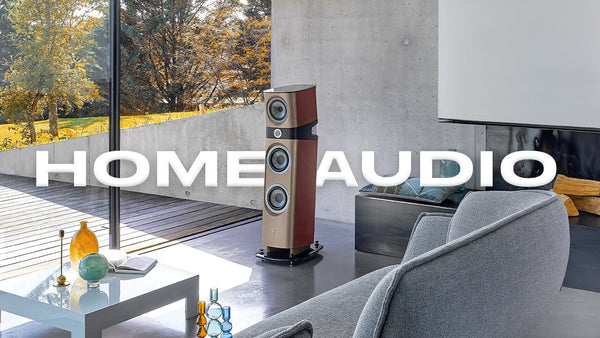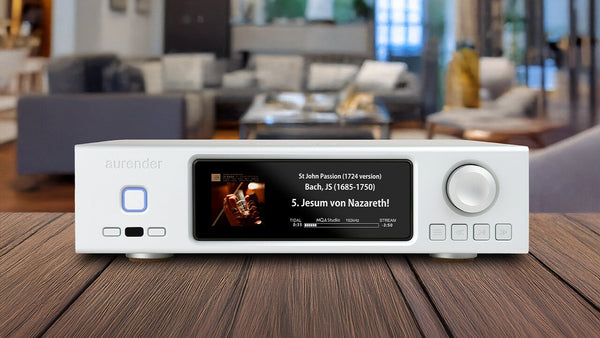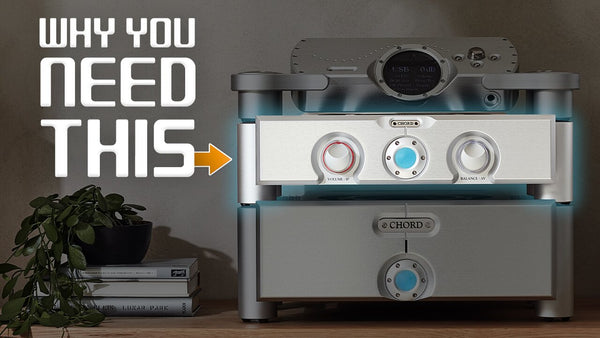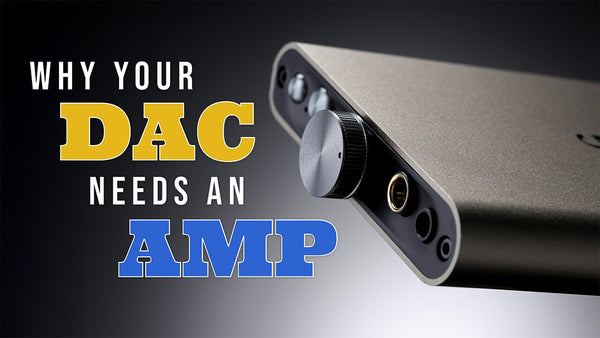Exploring DAC Types: A Comprehensive Guide to DAC Architecture
Read Time: Approx. 15 min.

DACs Deciphered: The 3 Major Types Explained
Have you ever wondered how the crystal-clear digital music files on your device transform into the rich, vibrant audio signals you hear through your loudspeakers? Or how a precisely calculated digital signal can command motors and actuators to move with pinpoint accuracy? The unsung hero behind these magical transformations is the Digital-to-Analog Converter, or DAC.
Hi-fi DACs come in many forms, from standalone units to integrated DAC/Amp combos, each with a myriad of specs and features. Beyond that, you have the internal circuit architecture of the DAC and the varying DAC chip flavors. Ring DACs, Ladder DACs, FPGA, resistors, off-the-shelf chips–it sounds complicated and technical. Without proper understanding, it can be, but there are a couple of things to keep in mind with different DAC technology. First: No DAC technology is perfect or better than the other. Some will swear Ring DACs are superior to Ladder DACs, and to that person, they might sound better–because remember, we all hear differently.
Second: The DAC is only a piece of the audio circuit puzzle. They do not indicate how the device will sound in tonality–you have to consider other aspects like the analog output stage, the length of the circuit, and more. Things like balanced versus single-ended, transformers, resistors, op-amps, and tube-based analog output stages can play a tremendous role in the coloration and sound signature of a device–sometimes way more than the DAC itself.
Understanding what exactly a DAC is, and why it matters, is the first piece of the puzzle. From there, you can get into the nitty-gritty of various types of DACs and which works best for your system, which we get into below. We have a plethora of DAC resources linked throughout this article to help you in your DAC buying journey. Whether you're a novice or a seasoned audiophile, DAC fundamentals are key to success in any hi-fi system.
FAQs on DACs: From Beginner to Audiophile
What Exactly is a DAC, and Why Does it Matter?
A DAC–short for Digital-to-Analog Converter (often abbreviated as a D/A Converter)–converts digital audio signals–represented as binary code, a series of 0s and 1s–into a continuous, analog electrical signal that speakers and headphones use to produce sound. Think of it as a translator bridging two fundamentally different languages: the discrete, step-by-step world of digital data and the fluid, infinitely variable world of analog waveforms.
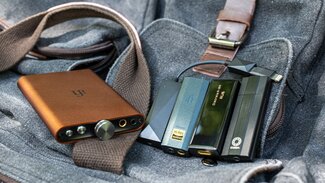
Why does it matter so much? Because virtually every interaction we have with technology that involves sound, light, or motion relies on this crucial conversion. Any electronic device that produces sound features a DAC, from your smartphone to your television, wireless earbuds, and car sound systems.
The DAC's primary function is to translate the digital data from stored audio files into an analog electrical signal.
What is a DAC & Why You Need One for Optimal Sound Quality
Understanding the Core Function: How a DAC Bridges the Digital and Anao Divide
The fundamental task of a DAC is to convert a sequence of digital values–input bits representing binary numbers–into an analog voltage or current. A digital audio file is a series of numbers, each representing the amplitude of the sound wave at a specific moment in time. The DAC receives these numbers, and for each one, outputs an analog voltage level that ideally matches the specified amplitude. When these analog voltage levels are strung together quickly, they form a continuous waveform that our ears perceive as sound. Understanding how a DAC works is essential for anyone serious about audio quality.
In a typical configuration, a DAC operates in two stages. The first is conversion, which takes the raw digital data entering through the source device and converts it into a lower-level analog signal. The incoming digital signal, represented by a sequence of binary numbers, undergoes sampling and quantization to capture its amplitude. The DAC then reconstructs the original waveform by converting these digital values into analog voltage levels.
The second stage involves amplification. The low-level analog signal is sent to your amplifier, boosting it to a level that speakers and headphones can drive. And once the desired gain is achieved, the analog signal is output to your speakers and headphones for you to enjoy as audible sound. This delicate process is essential to preserving the fidelity and nuances of the original audio signal. But how do different architectures achieve this transformation, and what are their respective strengths and weaknesses?
The accuracy and smoothness of the conversion depend on the DAC's design and quality
While the conversion process seems straightforward, many tiny internal components work together in a DAC to faithfully convert digital audio signals into analog audio. It typically involves a reference voltage (Vref), which defines the maximum possible output level, and a series of internal components—often resistors or current sources—that are precisely switched and combined based on the incoming digital code. Here's an overview of some of the main components used in DACs:
- Digital Input Interface: This component allows the DAC to receive digital audio signals from various sources. Accepts the digital bitstream data and passes it on to the subsequent stage
- Digital Decoding and Processing: In this stage, the incoming digital signal is decoded and processed. This can involve converting the data into a standard PCM format or handling other high-resolution audio formats like DSD
- DAC Chip: The heart of the circuit. It converts the processed digital audio data into an analog electrical signal. Uses various techniques, such as resistor-ladder networks or sigma-delta modulation, to perform the conversion
- Reference Voltage: A stable, accurate reference voltage required by the DAC chip to ensure precise conversion and an accurate analog output
- Analog Output Stage: After the data has been converted into analog form, it passes through an analog output stage. This stage typically includes amplifiers or output buffers to shape and amplify the signal to suitable levels for driving headphones or speakers. Output impedance is carefully managed in this stage to ensure proper signal transfer
- Output Filters: Filters used to smooth out the analog signal, removing any high-frequency noise or artifacts introduced during the conversion process
- Clocking Circuitry: High-quality clocking circuitry inside a DAC uses precise clock signals to synchronize the conversion process. Ensures accurate timing, reducing jitter and improving overall audio quality.
The Spectrum of DAC Architecture: Unpacking the Primary Types
The world of hi-fi DACs is rich with diverse architectures, each engineered to address specific design challenges related to speed, precision, power consumption, and cost. Beyond that, you have the ergonomics of a DAC, be it an external DAC, an integrated DAC, a USB Dongle DAC, etc., etc., etc. Understanding the fundamental DAC types is key to making an informed selection for any audio application. Each architecture presents unique trade-offs that must be carefully weighed against your requirements.
R-2R Ladder DACs: The Resistor Network Standard Bearer
The R-2R Ladder DAC stands as a classic and widely adopted architecture, prized for its simplicity and good performance. As the name suggests, it utilizes a precisely matched network of resistors, specifically with resistances in ratios of R and 2R. Each bit of the digital input controls a switch that connects either to a reference voltage or to ground, creating a current proportional to its binary weight. These currents are then summed to produce the final analog output voltage. If you look at a diagram of this process, it will resemble a ladder.
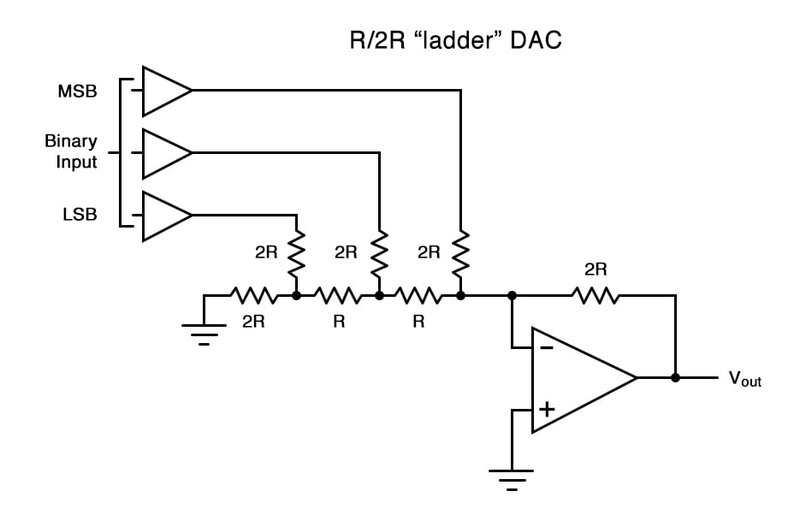
Think of it this way: One current source will always be following what the first bit in the digital signal is doing, and so on, for as many current sources are needed. As the current sources go on, the amount of energy they must generate gets smaller and smaller.
R-2R DACs are a solid choice for applications requiring a balance of cost-effectiveness and performance. When it comes to the sound of the DAC, ladder DACs and Ring DACs tend to sound more analog because they're using resistors. They're using an analog signal path to do the digital-to-analog conversion. An R-2R DAC is the perfect choice for those who want an analog sound that has a little more body to it.
Cayin is a popular brand that implements ladder DACs in many of its devices, resulting in astounding audio quality at affordable prices. The Bricasti M11 Series II R2R DAC is a premium 20-bit R-2R ladder DAC known for natural, transparent sound reproduction and a wide array of digital inputs, including network streaming.
Key Characteristics Include:
- Ease of manufacture: The repetitive nature of the R-2R network simplifies design and fabrication.
- Good linearity: When resistors are precisely matched, R-2R DACs offer excellent linearity.
- Moderate speed: They can achieve decent conversion speeds, suitable for many applications.
- Sensitivity to resistor matching: The primary drawback is that the accuracy and linearity are critically dependent on the precise matching of the R and 2R resistors. Any mismatch can introduce errors, particularly Differential Non-Linearity (DNL) and Integral Non-Linearity (INL).
Delta-Sigma (ΔΣ) DACs: The Oversampling Marvels
Another popular architecture, Delta-Sigma DACs represent a significant leap in performance, especially for applications demanding high-resolution and low noise. Their innovative approach involves "oversampling" the digital input signal at a much higher rate than the original frequency. This, combined with a noise-shaping modulator, pushes quantization noise to higher frequencies, where it can be effectively removed by a low-pass filter. The result is a highly accurate, low-noise analog output, even with a relatively simple 1-bit DAC at the core of the conversion.
Delta-Sigma DACs are the go-to for high-fidelity audio, professional sound equipment, and high-precision measurement systems where supreme audio quality and accuracy are non-negotiable. They yield a smooth and detailed output, making them a great choice for audiophiles demanding accuracy. Some audiophiles will argue they sound less dynamic than other DAC architectures, but that ultimately comes down to personal preference.

The TEAC UD-701N Headphone Amplifier, USB DAC, and Network Player uses a newly-developed TEAC Delta-Sigma discrete DAC, comprised of discrete circuitry with FPGA and proprietary algorithms for high-quality analog output. It supports playback of 22.5MHz DSD and 384kHz/32-bit PCM formats.
Key Characteristics Include:
- High resolution: They excel at achieving resolutions of 20 bits or more.
- Low noise and distortion: The oversampling and noise-shaping techniques effectively reduce in-band quantization noise.
- Built-in anti-aliasing: The extensive digital filtering inherent in the design also acts as an effective anti-aliasing filter.
- Complexity: The digital signal processing involved is considerably more complex than simpler architectures.
- Latency: The extensive digital filtering can introduce a slight delay or latency, which may be an issue in some real-time control systems.
Ring DACs: dCS Audio's Proprietary Architecture
A proprietary DAC architecture created by hi-fi manufacturer dCS Audio, Ring DACs convert audio signals with exceptional fidelity and ultra-low distortion. When dCS Audio saw a gap in the market and a demand for better performance, the dCS exclusive differential ring DAC was born.
Resistors (like all electronic components) have an element of error in their values. For resistors used in an R-2R Ladder DAC, the current generated by that section of the DAC could be lower or higher than needed. This leads to distortion in ladder DACs. A key point here is that the ladder DAC removes the link between the original signal and the physical resistor value errors associated with specific sample values.
Thus enters the Ring DAC. Instead of using off-the-shelf DAC chips, dCS builds its proprietary Ring DAC technology from the ground up. The Ring DAC uses a network of FPGAs (field programmable gate arrays) that are running proprietary dCS software that controls the digital-to-analog conversion process as well as digital filtering. This sophisticated mapping algorithm turns sources on and off in such a way that any component value errors are averaged out over time.
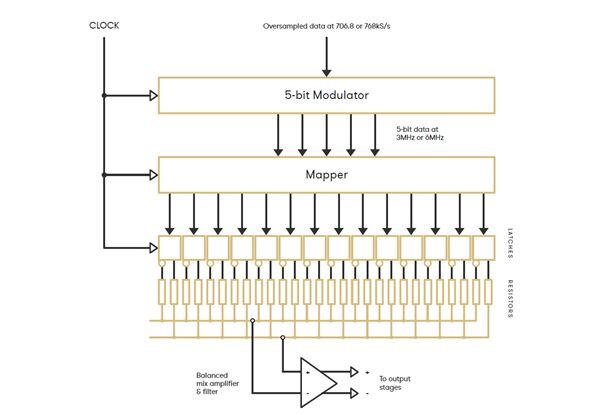
At first glance, the Ring DAC may look like a ladder DAC. The Ring DAC is based around a set of latches, all of which are turned on and off at high speeds to produce an equal amount of current. There is a latch and a resistor for each current source, and these current sources are fed to a summing bus.
The main difference is that the Ring DAC uses current sources of equal value; this is known as "unitary weighted" or "thermometer coded" DAC architecture. Furthermore, the Ring DAC does not use the same current source for the same bit every time.
Because any combination of current sources can be fired for any bit in the Ring DAC, the error generated is unrelated to the audio signal; it is de-correlated. This means that any errors are randomized and converted to white noise. This approach reduces distortion, or noise, to minuscule levels, and allows low-level details that are so important in our appreciation of music, to shine through.
The Ring DAC APEX is dCS' latest generation DAC board, equipped with some major sonic upgrades. The hardware further reduces noise and distortion and is around 12mB more linear than the dCS Ring DAC.
The Ring DAC is renowned for its ultra-wide bandwidth, technical accuracy, and ability to reveal astonishing levels of detail in digital recordings. The Ring DAC APEX delivers listeners enhanced dynamics, rhythm and timing, greater soundstage and image focus, more precise and tonally resolved voices, and an even greater sense of ease and naturalness.
dCS' proprietary Ring DAC technology is at the center of every dCS product. Audiophiles demanding the ultimate performance–the ones chasing after that last percentage point–should look no further than dCS components.
Key Characteristics Include:
- Proprietary Architecture: Developed exclusively by dCS Audio, featuring a "unitary weighted" or "thermometer coded" design using equal-value current sources.
- FPGA-controlled Mapping: Uses sophisticated FPGA-based algorithms to randomly activate current sources, averaging out component value errors over time.
- Error Decorrelation: Converts errors into randomized white noise uncorrelated with the audio signal, greatly reducing distortion.
- Ultra-wide Bandwidth and Accuracy: Delivers exceptional technical precision, detail resolution, and ultra-low distortion levels.
- Continuous Refinement: Latest Ring DAC APEX generation improves noise, linearity, and dynamics, ensuring state-of-the-art performance.
Key Performance Parameters: What to Look for in a DAC
Deciding to upgrade your DAC is the first step to superior sound quality. However, the world of DACs is overwhelming, with myriad specs and features to consider in various configurations. Where do you start? To help guide you through this labyrinth of DACs, let's break down the key elements to look for in a DAC.
Resolution (Number of Bits)
Resolution in a DAC refers to the number of discrete digital values a DAC can convert, typically expressed in bits. More bits lead to higher resolution, and higher resolution means finer granularity in the output signal, allowing for more precise control or a more accurate representation of an analog waveform. In essence, the higher the bit depth of a DAC, the more detailed and accurate the sound will be. However, noise, linearity, and temperature can also affect accuracy.
Typically, a CD-quality sound requires a 16-bit DAC, but for high-resolution audio files, you'll need a DAC capable of 24-bit or even 32-bit depth. The resolution of the DAC should match or exceed the resolution of the audio files you're playing. Using a 16-bit DAC for a 32-bit file will limit the level of detail you hear.
Ask yourself: What level of detail does your application truly demand?
Sampling Rate
The sampling rate (also known as sample rate) defines how many times per second the DAC converts a new digital input into an analog output. Measured in samples per second (SPS) or Hertz (Hz), it directly influences the maximum frequency content that can be accurately reproduced.
Generally speaking, the sampling rate must be at least twice the highest frequency component present in the analog signal being represented. For high-fidelity audio, rates like 44.1 kHz, 96 kHz, or even 192 kHz are common, while high-speed communications may demand gigasamples per second.
Ask yourself: Can your system keep up with the data throughput requirements?
Signal-to-Noise Ratio (SNR)
Signal-to-Noise Ratio (SNR) is a crucial metric, expressing the ratio of the desired signal power to the unwanted noise power present in the DAC's output. Measured in decibels (dB), a higher SNR indicates a cleaner, less noisy output signal. This is particularly vital in audio applications, where a low SNR can manifest as audible hiss or background interference, compromising the listening experience.
Ask yourself: How much background noise can your application tolerate before performance is degraded?
Dynamic Range (DR)
Dynamic Range quantifies the difference between the loudest (maximum output) and quietest (noise floor) signals a DAC can reproduce without significant distortion. Also expressed in decibels, it essentially tells you how wide a range of signal amplitudes the DAC can handle. A high dynamic range is imperative for applications like audio, where preserving the subtle nuances of quiet passages alongside the full power of loud sections is critical.
Ask yourself: Are you capturing the full breadth of your signal's intensity?
Total Harmonic Distortion Plus Noise (THD+N)
Total Harmonic Distortion plus Noise (THD+N) is a comprehensive measurement that combines the effects of both harmonic distortion (unwanted frequencies that are integer multiples of the fundamental signal) and broadband noise. It is typically expressed as a percentage or in decibels. A lower THD+N value indicates a purer output signal with less unwanted content. This parameter is extremely important in high-precision audio and instrumentation, where signal fidelity is paramount.
Ask yourself: How faithful is your DAC to the original digital data?
Linearity (Internal Non-Linearity- INL and Differential Non-Linearity- DNL)
Linearity is a measure of how accurately the DAC's analog output corresponds to its digital input, ideally following a straight line.
Excellent linearity is critical for precision control, instrumentation, and any application where the exact relationship between digital input and analog output must be maintained.
Ask yourself: Can your system afford even the slightest deviation from the ideal?
- Integral Non-Linearity (INL) measures the maximum deviation of the DAC's actual output from its ideal straight-line transfer function. It's an overall measure of how "straight" the output curve is.
- Differential Non-Linearity (DNL) measures the maximum deviation of the step size between adjacent digital codes from the ideal step size (which is one LSB). A DNL error greater than ±1 LSB can lead to missing codes or non-monotonic behavior, where the output might decrease even when the digital input increases.
Choosing the Right DAC
Choosing the right DAC for your system largely depends on your individual needs and existing hi-fi setup. You want a DAC that's compatible with your system. Ask yourself: Do the connections (inputs and outputs) match those of your digital source device, amplifier, and headphones or speakers? What about the resolution? Can it support the file formats you intend to play?
A well-chosen DAC ensures not only functionality, but optimal performance, whether that means pristine sound, precise control, or efficient communication. In the same breath, a poorly matched DAC can introduce noise, distortion, or inaccuracy, compromising the entire system's integrity. Don't forget to evaluate the DAC's technical specifications, such as the signal-to-noise ratio, total harmonic distortion, and dynamic range, to ensure it's the right fit for your hi-fi system.
- Compatibility
- Inputs and Outputs
- Resolution
- Sound Signature
For Audio Enthusiasts: Which DAC Type Delivers Sonic Purity?
For discerning audiophiles and audio professionals, Delta-Sigma DACs are generally the gold standard. Their high resolution (often 24-bit or 32-bit), exceptional SNR, and low THD+N deliver the sonic purity and dynamic range required for high-fidelity audio playback. While R-2R Ladder DACs also have a devoted following among some audiophiles for their natural sound quality, Delta-Sigma typically offers superior measured performance. The primary consideration is signal fidelity and the ability to reproduce subtle details without noise or distortion.
For Precision Control Systems: Where Accuracy is Non-Negotiable
In applications where precise positioning or voltage control is critical, R-2R Ladder DACs or Ring DACs are often preferred. Here, linearity and monotonicity are paramount. While Delta-Sigma DACs offer high resolution, their inherent latency due to extensive digital filtering can be a drawback in real-time control loops. R-2R DACs, with their direct conversion, provide predictable and reliable output. For even higher precision, Ring DACs offer a good balance of linearity and speed. Many industrial systems from analog devices manufacturers are built around these architectures for their reliability.
For Cost-Sensitive Applications: Balancing Performance and Budget
When budget constraints are a significant factor, but optimal performance is still desired, R-2R Ladder DACs are often the most practical choice. Low-cost R-2R DACs offer a step up in resolution and linearity without breaking the bank, suitable for many general-purpose applications. The key here is to carefully evaluate the minimum acceptable performance against the cost of the component.
Breaking Down the Best DACs on the Market
Making Your Informed Choice
The world of Digital-to-Analog Converters is diverse, fascinating, and constantly evolving. From the delicate nuances of high-fidelity audio to the brute force precision of industrial control, a DAC is always at the heart of the conversion. We've explored the foundational architectures, from the resistor-based simplicity of R-2R to the oversampling genius of Delta-Sigma, and delved into the critical parameters that define their performance.
Now, armed with this knowledge, you are better equipped to navigate the complex landscape of hi-fi DAC selection. Don't simply pick the highest-spec component or the most popular one on the market; instead, align your choice with the specific demands of your audio system. Consider the required resolution, speed, noise tolerance, sound quality, and of course, budget. By carefully evaluating these factors against the strength of each DAC architecture, you can make an informed decision that ensures optimal performance and efficiency for your d-to-a needs. Which DAC will unlock the full potential of your next project? The power to choose wisely is now yours.
We've got an entire selection of hi-fi DACs, from standalone units to integrated components in the form of DAPs, music streamers, portable DAC/Amps and more. Check out our entire collection of DACs and utilize our expert advice resources to aid in the buying process.
Related Videos
Our dCS Lina Network DAC EXPLODED!
DACs Deciphered: The 4 Major Types Explained
Top 5 Desktop DACs












